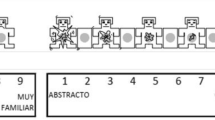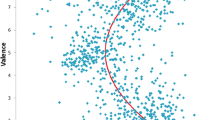Abstract
The present study provides a French child database containing a large corpus of words (N=600) that were rated on emotional valence (positive, neutral, and negative) by French children differing in both age (5, 7, and 9 years old) and sex (girls and boys). Good response reliability was observed in each of the three age groups. The results showed some age differences in the children’s ratings. With increasing age, the percentage of words rated positive decreased, whereas the percentage of neutral words increased and the percentage of negative words remained stable. Our study did not reveal marked differences across sex groups. The database compiled here should become a useful tool for experimental studies in which verbal material is used with children. It would be worthwhile in future research to study how children process emotional words and also to control the emotional variable in the same way as other linguistic variables in the experimental design. The norms from this study may be downloaded from brm.psychonomic-journals.org/content/supplemental.
Similar content being viewed by others
References
Alario, F.-X., & Ferrand, L. (1999). A set of 400 pictures standardized for French: Norms for name agreement, image agreement, familiarity, visual complexity, image variability, and age of acquisition. Behavior Research Methods, Instruments, & Computers, 31, 531–552.
Bonin, P., Méot, A., Aubert, L., Malardier, N., Niedenthal, P., & Capelle-Toczek, M.-C. (2003). Normes de concrétude, de valeur d’imagerie, de fréquence subjective et de valence émotionnelle pour 866 mots. L’Année Psychologique, 104, 655–694. doi:10.3406/ psy.2003.29658
Bonin, P., Peereman, R., Malardier, N., Méot, A., & Chalard, M. (2003). A new set of 299 pictures for psycholinguistic studies: French norms for name agreement, image agreement, conceptual familiarity, visual complexity, image variability, age of acquisition, and naming latencies. Behavior Research Methods, Instruments, & Computers, 35, 158–167.
Bradley, M. M., & Lang, P. L. (1999). Affective norms for English words (ANEW). Gainesville: University of Florida, NIMH Center for the Study of Emotion and Attention.
Cook, G. I., Hicks, J. L., & Marsh, R. L. (2007). Source monitoring is not always enhanced for valenced material. Memory & Cognition, 35, 222–230.
Daleiden, E. L., & Vasey, M. V. (1997). An information-processing perspective on childhood anxiety. Clinical Psychology Review, 17, 407–429. doi:10.1016/S0272-7358(97)00010-X
Davidson, D., Luo, Z., & Burden, M. J. (2001). Children’s recall of emotional behaviours, emotional labels, and nonemotional behaviours: Does emotion enhance memory? Cognition & Emotion, 15, 1–26. doi:10.1080/0269993004200105
Denham, S. A., & Couchoud, E. A. (1990). Young preschoolers’ ability to identify emotions in equivocal situations. Child Study Journal, 20, 153–169.
Dewhurst, S. A., & Parry, L. A. (2000). Emotionality, distinctiveness, and recollective experience. European Journal of Cognitive Psychology, 12, 541–551. doi:10.1080/095414400750050222
Doerksen, S., & Shimamura, A. R. (2001). Source memory enhancement for emotional words. Emotion, 1, 5–11. doi:10.1037/1528-3542.1.1.5
Dunn, J., Bretherton, I., & Munn, P. (1987). Conversations about feelings between mothers and their young children. Developmental Psychology, 23, 132–139. doi:10.1037/0012-1649.23.1.132
Ferrand, L., Grainger, J., & New, B. (2003). Normes d’âge d’acquisition pour 400 mots monosyllabiques. L’Année Psychologique, 104, 445–468. doi:10.3406/psy.2003.29645
Ferré, P. (2003). Effects of level of processing on memory for affectively valenced words. Cognition & Emotion, 17, 859–880. doi:10.1080/02699930302309
Harris, P. L. (1985). What children know about the situations that provoke emotion. In M. Lewis & C. Saarni (Eds.), The socialization of affect (pp. 161–185). New York: Plenum.
Kensinger, E. A., & Corkin, S. (2003). Memory enhancement for emotional words: Are emotional words more vividly remembered than neutral words? Memory & Cognition, 31, 1169–1180.
Kissler, J., Assadollahi, R., & Herbert, C. (2006). Emotional and semantic networks in visual word processing: Insights from ERP studies. Progress in Brain Research, 156, 147–183.
Lachaud, C. M. (2007). CHACQFAM: Une base de données renseignant l’âge d’acquisition estimé et la familiarité pour 1225 mots monosyllabiques et bisyllabiques du Français. L’Année Psychologique, 1, 39–63.
Lagattuta, K. H., Wellman, H. M., & Flavell, J. H. (1997). Preschoolers’ understanding of the link between thinking and feeling: Cognitive cuing and emotional change. Child Development, 68, 1081–1104.
Lang, P. J., Bradley, M. M., & Cuthbert, M. M. (1997). Motivated attention: Affect, activation and action. In P. J. Lang, R. F. Simons, & M. T. Balaban (Eds.), Attention and orienting: Sensory and motivational processes (pp. 97–135). Mahwah, NJ: Erlbaum.
McManis, M. H., Bradley, M. M., Berg, W. K., Cuthbert, B. N., & Lang, P. J. (2001). Emotional reactions in children: Verbal, physiological, and behavioral responses to affective pictures. Psychophysiology, 38, 222–231. doi:10.1017/S0048577201991140
Messina, D., Morais, J., & Cantraine, F. (1989). Valeur affective de 904 mots de la langue française. Cahiers de Psychologie Cognitive, 9, 165–187.
Monnier, C., & Syssau, A. (2008). Semantic contribution to verbal short-term memory: Are pleasant words easier to remember than neutral words in serial recall and serial recognition? Memory & Cognition, 36, 35–42.
Neshat-Doost, H. T., Moradi, A. R., Taghavi, M. R., Yule, W., & Dalgleish, T. (1999). The development of a corpus of emotional words produced by children and adolescents. Personality & Individual Differences, 27, 433–451. doi:10.1016/S0191-8869(98)00253-0
Neshat-Doost, H. T., Taghavi, M. R., Moradi, A. R., Yule, W., & Dalgleish, T. (1998). Memory for emotional trait adjectives in clinically depressed youth. Journal of Abnormal Psychology, 107, 642–650. doi:10.1037/0021-843X.107.4.642
Niedenthal, P. M., Auxiette, C., Nugier, A., Dalle, N., Bonin, P., & Fayol, M. (2004). A prototype analysis of the French category “émotion.” Cognition & Emotion, 18, 289–312. doi:10.1080/02699930341000086
Osgood, C. E., Suci, G. J., & Tannenbaum, P. H. (1957). The measurement of meaning. Urbana: University of Illinois Press.
Russell, J. A., & Widen, S. C. (2002). A label superiority effect in children’s categorization of facial expressions. Social Development, 11, 30–52. doi:10.1111/1467-9507.00185
Stein, N. L., & Levine, L. J. (1989). The causal organisation of emotional knowledge: A developmental study. Cognition & Emotion, 3, 343–378. doi:10.1080/02699938908412712
Stevenson, R. A., Mikels, J. A., & James, T. W. (2007). Characterization of the Affective Norms for English Words by discrete emotional categories. Behavior Research Methods, 39, 1020–1024.
Syssau, A., & Font, N. (2005). Evaluations des caractéristiques émotionnelles d’un corpus de 604 mots. Bulletin de Psychologie, 58, 361–367.
Trabasso, T., Stein, N. L., & Johnson, L. R. (1981). Children’s knowledge of events: A causal analysis of story structure. In G. H. Bower (Ed.), The psychology of learning and motivation: Advances in research and theory (Vol. 15, pp. 237–281). New York: Academic Press.
Vasa, R. A., Carlino, A. R., London, K., & Min, C. (2006). Valence ratings of emotional and non-emotional words in children. Personality & Individual Differences, 41, 1169–1180. doi:10.1016/j.paid.2006.03.025
Whissell, C. M., & Nicholson, H. (1991). Children’s freely produced synonyms for seven key emotions. Perceptual & Motor Skills, 72, 1107–1111. doi:10.2466/PMS.72.4.1107-1111
Widen, S. C., & Russell, J. A. (2003). A closer look at preschoolers’ freely produced labels for facial expressions. Developmental Psychology, 39, 114–128. doi:10.1037/0012-1649.39.1.114
Widen, S. C., & Russell, J. A. (2004). The relative power of an emotion’s facial expression, label, and behavioral consequence to evoke preschoolers’ knowledge of its cause. Cognitive Development, 19, 111–125. doi:10.1016/j.cogdev.2003.11.004
Author information
Authors and Affiliations
Corresponding author
Electronic supplementary material
Rights and permissions
About this article
Cite this article
Syssau, A., Monnier, C. Children’s emotional norms for 600 French words. Behavior Research Methods 41, 213–219 (2009). https://doi.org/10.3758/BRM.41.1.213
Received:
Accepted:
Published:
Issue Date:
DOI: https://doi.org/10.3758/BRM.41.1.213




